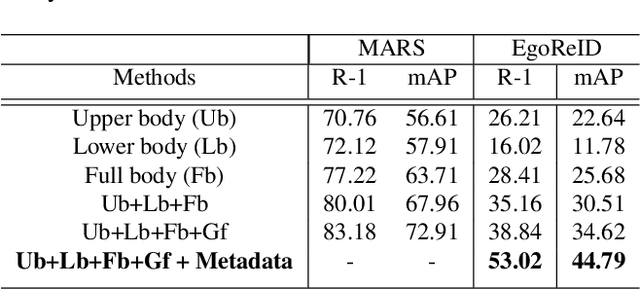Yonatan Tariku Tesfaye
EgoReID: Person re-identification in Egocentric Videos Acquired by Mobile Devices with First-Person Point-of-View
Dec 22, 2018



Abstract:Widespread use of wearable cameras and recording devices such as cellphones have opened the door to a lot of interesting research in first-person Point-of-view (POV) videos (egocentric videos). In recent years, we have seen the performance of video-based person Re-Identification (ReID) methods improve considerably. However, with the influx of varying video domains, such as egocentric videos, it has become apparent that there are still many open challenges to be faced. These challenges are a result of factors such as poor video quality due to ego-motion, blurriness, severe changes in lighting conditions and perspective distortions. To facilitate the research towards conquering these challenges, this paper contributes a new, first-of-its-kind dataset called EgoReID. The dataset is captured using 3 mobile cellphones with non-overlapping field-of-view. It contains 900 IDs and around 10,200 tracks with a total of 176,000 detections. Moreover, for each video we also provide 12-sensor meta data. Directly applying current approaches to our dataset results in poor performance. Considering the unique nature of our dataset, we propose a new framework which takes advantage of both visual and sensor meta data to successfully perform Person ReID. In this paper, we propose to adopt human body region parsing to extract local features from different body regions and then employ 3D convolution to better encode temporal information of each sequence of body parts. In addition, we also employ sensor meta data to determine target's next camera and their estimated time of arrival, such that the search is only performed among tracks present in the predicted next camera around the estimated time. This considerably improves our ReID performance as it significantly reduces our search space.
Applications of a Graph Theoretic Based Clustering Framework in Computer Vision and Pattern Recognition
Jan 07, 2018



Abstract:Recently, several clustering algorithms have been used to solve variety of problems from different discipline. This dissertation aims to address different challenging tasks in computer vision and pattern recognition by casting the problems as a clustering problem. We proposed novel approaches to solve multi-target tracking, visual geo-localization and outlier detection problems using a unified underlining clustering framework, i.e., dominant set clustering and its extensions, and presented a superior result over several state-of-the-art approaches.
Multi-Target Tracking in Multiple Non-Overlapping Cameras using Constrained Dominant Sets
Jun 19, 2017



Abstract:In this paper, a unified three-layer hierarchical approach for solving tracking problems in multiple non-overlapping cameras is proposed. Given a video and a set of detections (obtained by any person detector), we first solve within-camera tracking employing the first two layers of our framework and, then, in the third layer, we solve across-camera tracking by merging tracks of the same person in all cameras in a simultaneous fashion. To best serve our purpose, a constrained dominant sets clustering (CDSC) technique, a parametrized version of standard quadratic optimization, is employed to solve both tracking tasks. The tracking problem is caste as finding constrained dominant sets from a graph. In addition to having a unified framework that simultaneously solves within- and across-camera tracking, the third layer helps link broken tracks of the same person occurring during within-camera tracking. In this work, we propose a fast algorithm, based on dynamics from evolutionary game theory, which is efficient and salable to large-scale real-world applications.
 Add to Chrome
Add to Chrome Add to Firefox
Add to Firefox Add to Edge
Add to Edge